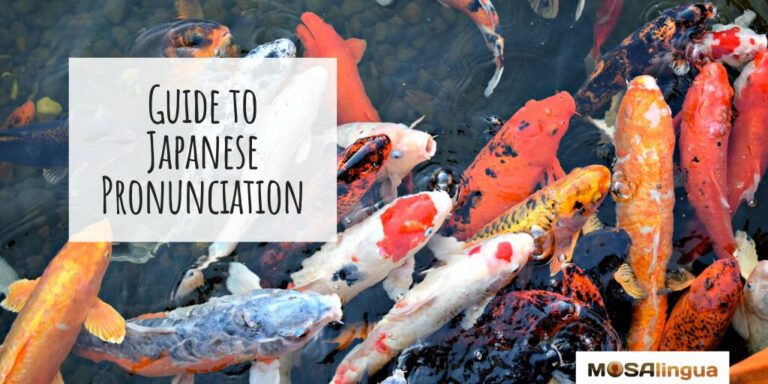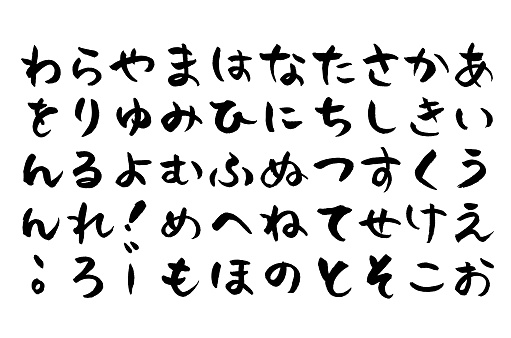Did you know that learning to pronounce Japanese words is one of the easiest parts of learning Japanese? Does that come as a surprise? If so, I hope you’ll find this article enlightening! I’m going to show you why Japanese pronunciation isn’t anything to stress out about. On the contrary, it can actually be a source of motivation as you broaden your vocabulary. And because good pronunciation is a crucial part of making yourself understood in any language, I’ll also share some tips and advice to help you sound more like a native speaker.

Is Japanese pronunciation easy?
First of all, you might think that Japanese is a difficult language to learn and master for a variety of reasons. It is indeed an isolated language, meaning that it shares nothing with Latin-based languages, nor is it part of the large family of Indo-European languages. So, if it’s so culturally and linguistically different from what we’re used to, how can it be that easy to pronounce?
Japanese has fewer phonemes than English
A phoneme is a unit of sound that can be isolated in any given language. English contains 44 phonemes, but Japanese has only 14 consonants and 5 vowels and thus significantly fewer phonemes. In other words, there are no new sounds in Japanese for an English speaker. The five basic vowels are: a, e, i, o, u which, combined with the 14 consonants, form a syllabary of 46 characters, called kanas. It’s important to bear these facts in mind before introducing Japanese pronunciation.
Alternating vowels and consonants
First, it’s important to understand that Japanese is a syllabary language. This means that a consonant is always followed by a vowel (except for the final character ん (n), which we’ll come back to later). The regularity of these consonant + vowel letter combinations makes the pronunciation very easy for non-native speakers to grasp.
Japanese has no diphthongs
On the other hand, there are no diphthongs in Japanese. A diphthong is a gradual, uninterrupted transition from a strong vowel to a weak vowel. For example, in the English word “day,” there’s a gradual transition from the vowel /e/ (half-open) to the vowel /ɪ/ (half-closed).
This never happens in Japanese. Two consecutive vowels will simply indicate two separate syllables.
Example: あおい – aoi (which means “blue”) contains three vowels which are each pronounced distinctly: a-o-i.
Listen to the pronunciation:
Tempo and rhythm
Another simplifying aspect of Japanese language pronunciation is the regularity of its rhythm. Each syllable has the same duration and the same accentuation. Let’s look at an example. The word for “Africa” – アフリカ (afurica) has four syllables that are pronounced with perfectly even stress:
Gentle pronunciation
The beauty of this language lies in the ease of its pronunciation and the smoothness of its intonation. However, it’s not uncommon to hear learners insert strong accents where there’s no need for them. Japanese cinema, particularly samurai films and manga, may have contributed to this phenomenon. Of course, there are ways of speaking that are traditionally marked by a specific status, such as for samurai or geisha. But as a general rule, Japanese is a gentle, pleasant language with very little accentuation.
Let’s take, for example, こんにちは (konnichiwa) and さようなら (sayōnara). I invite you to practice pronouncing these two words with an even tone, being careful not to put more stress on any one syllable.
Listen to an example of the pronunciation for こんにちは (konnichiwa):
Listen to an example of the pronunciation for さようなら (sayōnara):
Sounds that you should know
Even though Japanese pronunciation is generally straightforward, there are a few sounds and letters that might require a little additional practice. These letters, though they are transcribed using the Latin alphabet, are not pronounced using the sounds you expect. Let’s have a look at these.
The F sound
The Japanese version is somewhat different from the sound you’re familiar with. The sound written as [f] more closely resembles the [h] sound. Exhale air from the back of your throat in a rapid puff. The only difference with the [h] sound is that you have to purse your lips as if you were whistling. The resulting sound should resemble a light, frictionless [f]. You can practice pronouncing these words:
ふね (fune – boat)
ふうせん (fūsen – ball)
The R sound
This sound is closer to the [l], but more pronounced. To pronounce the Japanese [r], you first need to feel where the tip of your tongue goes when you pronounce the [d] sound of “dog” and the [l] sound of “lasagna.” The tongue should rest in two different places. To pronounce the Japanese [r], you need to find the point between these two places: that’s where your tongue should be. You can practice these words:
らーめん (rāmen – Japanese noodles of Chinese origin)
りょうり (ryōri – cooking, cuisine)
The N sound
The transcription of the character ん as [n] is not really faithful to the wide variety of sounds this letter produces. This is a character that indicates nasalization. It’s also the only consonant letter that doesn’t combine with a vowel. Let’s take a look at these different pronunciations:
- At the end of a word, pronounce the ん as [ng], like in the word “parking.”
Example: nihon (Japan)
- Pronounce it the same way when it comes before the sounds [k] and [g].
Example: ongaku (music)
- When it comes before the sounds [s], [z], [d], [n], pronounce the ん as [n].
Example: onsen (hot springs)
- In front of the sounds [m], [b], or [p], pronounce the ん [m].
Example: shinbun (newspaper)
Long vowel sounds
Long vowels are called chōon in Japanese. They consist of a drawn-out hiragana, obtained by the addition of a vowel.
You can lengthen the vowel sound of a character by adding either: あ, い、, or う depending on the vowel and according to the following rules:
- If the hiragana ends with an [a] sound, then you must lengthen it with the addition of あ.
- If the hiragana ends with an [i] or [e] sound, then you must lengthen it with the addition of い.
- If the hiragana ends with an [o] or [u] sound, then you must lengthen it with the addition of う.
Let’s have a look at a few word pairs that help illustrate these long vowels.
- Long [a] vs short [a]
おばあさん obāsan (grandmother) vs おばさん obasan (aunt)
- Long [e] vs short [e]
きれい kirei (pretty, beautiful) (long E) vs きれ kire (a slice, a piece)
- Long [i] vs short [i]
おじいさん ojīsan (grandfather) vs おじさん ojisan (uncle)
- Long [o] vs short [o]
通り (とおり) tōri (street) vs 鳥 (とり) tori (bird)
But be careful – the chōon for the [o] sound is often made with the character う [u]. Have a look at the words below, and practice lengthening the [o] and not pronouncing the final [u].
たんじょうび (tanjōbi) – birthday
べんきょう (benkyō) – studies
おはよう (ohayō) – hello
As you’ve probably noticed with the examples above, in rōmaji a long vowel simply has a line above the vowel.
Double consonants with the small つ (tsu)
Unlike other kana, the small つ does not represent a syllable. Instead, it marks a double consonant, which comes with a slight pause between letters. You can transcribe this to rōmaji by simply writing the doubled consonant twice.
So let’s have a look at what this means in practice:
ゆっくり (yukkuri) – slowly
いっしょに (ishshoni)- together
すっぱい (suppai) – sour
BONUS: Japanese Pronunciation for Beginners [VIDEO]
And of course, because there’s no better way to improve your pronunciation than to train your ear by listening, I also have a short video for you to watch that covers many of the points mentioned above. You can watch it below or on YouTube.
The video is in English (and Japanese) but subtitles are available in several languages.
If you enjoy this video, then be sure to subscribe to our YouTube channel! We’re constantly adding new videos with advice, insight, and tips to help you navigate the language learning process.
Conclusion
To conclude, I’d say that the sounds [R], [F], and [N], as well as the drawing out of vowels and doubling of consonants, are likely to be the most different aspects as you get used to Japanese pronunciation. My advice: practice using the shadowing technique. This method consists of listening to a native speaker and repeating each word they say, just like an echo (or a shadow). Your goal is to replicate the sounds exactly as they pronounce them. This is a great way to train your ear and perfect your pronunciation and intonation.
Go further
If you enjoyed this article, you might also like:

Comments